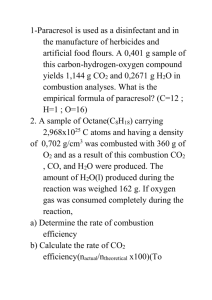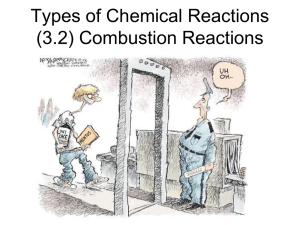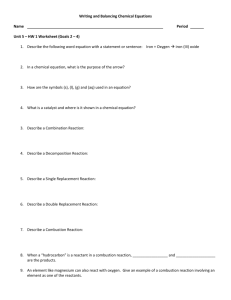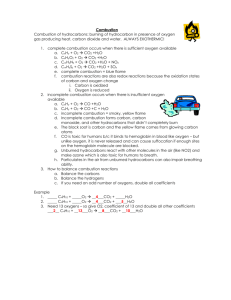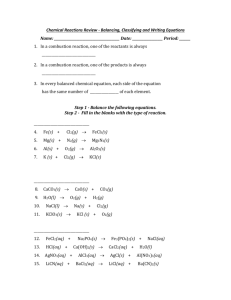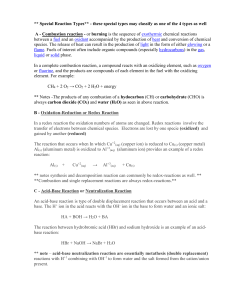CHEMISTRY 11 TEACHER’S CHAPTER 5 NOTES
advertisement
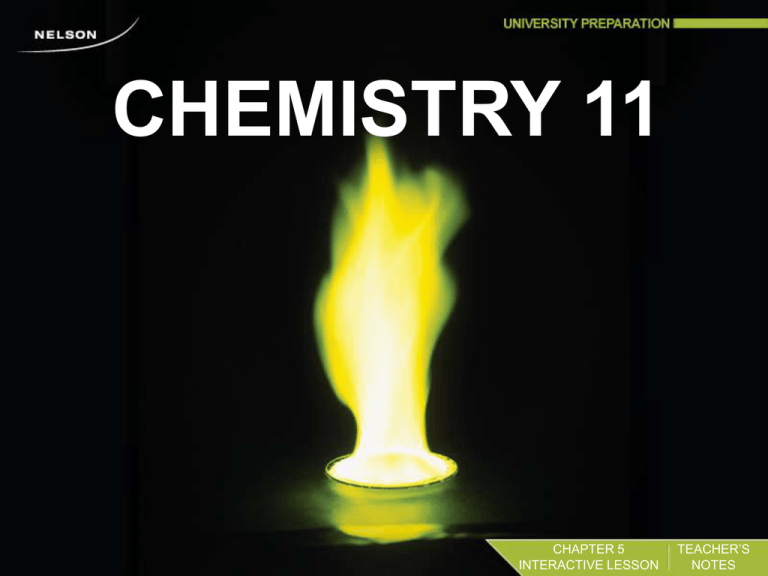
CHEMISTRY 11 CHAPTER 5 INTERACTIVE LESSON TEACHER’S NOTES FOR THE TEACHER Lesson Objectives • Review, reinforce, and extend the concepts in Chapter 5: Chemical Processes. • This lesson relates to expectations C1.1, C1.2, C2.1, C2.2, C2.6, C3.1, C3.2 and C3.3. Lesson Notes Slide 5 • By completing this slide, students will find themselves summarizing the key differences between complete and incomplete combustion. • As an extension, you might ask students whether they think the incomplete combustion equation given is the only possible one for ethyne (C2H2). Another possible equation is: 3C2H2(g) + 7O2(g) → CO(g) + 5CO2(g) + 3H2O(l) + energy; but the principle doesn't depend on finding this exact equation. FOR THE TEACHER Lesson Notes Slide 7 • The discussion can be led into the issue of pure research: whose role should it be to fund this? How can a return on pure research be assessed, if we are looking at the occasional spectacular success but also many dead ends? Slides 8 • Students develop a schematic of the chemical reactions for nitric oxide pollution on the one hand, and catalytic conversion on the other. Slide 9 • The purpose of this slide is to help students organize their knowledge of the principles and types of neutralization reactions. FOR THE TEACHER Lesson Notes Slides 10 and 11 • Students complete these two slides to review metallurgical processing and its environmental impact. Slide 13 • Students have an opportunity to think analytically about the various options for remediation, potentially extending into an evaluative exercise. Some of the advantages and disadvantages require some thought beyond the specific content of Section 5.6. Section 5.1 Complete vs Incomplete Combustion Complete the table with the phrases and equations below. C2H4(g) + 3O2(g) → 2CO2(g) + 2H2O(l) + energy energy CO2 Oxygen Incomplete Combustion Complete Combustion limited not limited H2O C CO C2H2(g) + 2O2(g) → CO(g) + CO2(g) + H2O(l) + energy Example of Equation Products Section 5.2 Chance Discoveries Look at the images. Match each accidental discovery with its origins and an example of its use. protective building material unsuitable clear plastic seaweed reacted refrigerant disinfecting agent bone repair Iodine Origin An example of its use Teflon Superglue Discussion: Chance Discoveries Section 5.2 The board of a high-tech company decides that, to save money, only research projects with a defined product as an outcome will be funded. Why might this be unwise? Section 5.3 Catalytic Conversion This diagram shows how the polluting effects of nitrogen combustion in vehicle engines can be largely eliminated by catalytic conversion. Match each chemical equation to the correct position in the diagram. 2NO(g) → N2(g) + O2(g) N2(g) + O2(g) → 2NO(g) 2NO2(g) + H2O(l) → HNO3(aq) + HNO2(aq) 2NO(g) + O2(g) → 2NO2(g) Combustion in the engine Catalytic conversion Without catalytic conversion Further reaction in the atmosphere Formation of acids in the atmosphere Section 5.4 Neutralization Match the appropriate substance to the boxes below to complete the neutralization reactions. H2CO3(aq) H2O(l) HCl(aq) NaCl(aq) CO2(g) NaHCO3(aq) Na2CO3(aq) NaOH(aq) Acid + Base: → + + Carbonic acid + Base: → + + Acid+ baking soda: → + + + Acid+ carbonate compound: + → + + Metallurgy: Processing and Purifying Click the image on the right to follow the processing and purification of copper from its ore. Section 5.5 Extracting and Purifying Copper Metallurgy: Processing and Purifying Section 5.5 Complete the following statements about metallurgical processing and environmental impact. acid mine hydrophilic smelting sulfides air bubbles oxygen sulfuric acid calcium carbonate physical sulphur dioxide flotation pyrite 1. 2. 3. 4. _______________ processing of ore may involve grinding and _______________. In _______________, the the hydrophobic ends of anions attach themselves to _______________ and the _______________ ends attach to the ore. Flash _______________ takes place in almost pure _______________. It results in more concentrated _______________, which is easier and cheaper to convert to _______________. _______________ drainage involves the acidification of water by _______________ such as _______________ (FeS2). It can be offset by using _______________. Discussion: Metallurgy: Processing and Purifying Section 5.5 Increasing the efficiency of processing, and using methods to reduce environmental impact, are "production-end" ways to make metal industries more “green.” How else can we "green" the role of metal in our society? Remediation Approaches Section 5.6 For each form of remediation, identify one advantage and one disadvantage. 1. Soil flushing 4. Electrolysis 2. Stabilization and solidification 3. Chemical oxidation 5. Phytoremediation Section 5.7 Principles of Green Chemistry Look at the examples and visuals. Identify the principles of Green Chemistry. Use chemicals with low environmental impact Use less energy Use catalysts Nylon, usually made from oil based material such as benzene. Energy costs for blast furnaces can be reduced. Use renewable materials Waste not CFCs are no longer used to make styrofoam. Making sulfuric acid involves a catalyst, V2O5. An exhaust hood for battery recycling. ANSWERS CHAPTER 5 INTERACTIVE LESSON TEACHER’S NOTES Complete vs Incomplete Combustion Section 5.1 Complete the table with the phrases and equations below. Oxygen Example of Equation Products Incomplete Combustion limited C2H2(g) + 2O2(g) → CO(g) + CO2(g) + H2O(l) + energy C CO CO2 H2O energy Complete Combustion not limited C2H4(g) + 3O2(g) → 2CO2(g) + 2H2O(l) + energy CO2 H2O energy Section 5.2 Chance Discoveries Look at the images. Match each accidental discovery with its origins and an example of its use. Iodine Origin An example of its use Teflon Superglue seaweed reacted refrigerant unsuitable clear plastic disinfecting agent protective building material bone repair Section 5.3 Catalytic Conversion This diagram shows how the polluting effects of nitrogen combustion in vehicle engines can be largely eliminated by catalytic conversion. Match each chemical equation to the correct position in the diagram. Combustion in the engine N2(g) + O2(g) → 2NO(g) Catalytic conversion 2NO(g) → N2(g) + O2(g) Without catalytic conversion Further reaction in the atmosphere 2NO(g) + O2(g) → 2NO2(g) Formation of acids in the atmosphere 2NO2(g) + H2O(l) → HNO3(aq) + HNO2(aq) Section 5.4 Neutralization Match the appropriate substance to the boxes below to complete the neutralization reactions. H2CO3(aq) H2O(l) HCl(aq) NaCl(aq) CO2(g) Na2CO3(aq) NaHCO3(aq) NaOH(aq) Acid + Base: HCl(aq) + NaOH(aq) → H2O(l) + NaCl(aq) Carbonic acid + Base: H2CO3(aq) + 2 NaOH(aq) →2 H2O(l) + Na2CO3(aq) Acid+ baking soda: HCl(aq) + NaHCO3(aq) → CO2(g) + H2O(l) + NaCl(aq) Acid+ carbonate compound: 2 HCl(aq) + Na2CO3(aq) → CO2(g) + H2O(l) + 2 NaCl(aq) Metallurgy: Processing and Purifying Section 5.5 Complete the following statements about metallurgical processing and environmental impact. 1. 2. 3. 4. _______________ physical processing of ore may involve grinding and _______________. flotation flotation In _______________, the the hydrophobic ends of anions attach themselves to _______________ and the _______________ ends air bubbles hydrophilic attach to the ore. Flash _______________ smelting takes place in almost pure _______________. oxygen sulphur dioxide which is easier and It results in more concentrated _______________, sulfuric acid cheaper to convert to _______________. _______________ drainage involves the acidification of water by acid mine pyrite sulfides _______________ such as _______________ (FeS2). It can be offset by using _______________. calcium carbonate Section 5.7 Principles of Green Chemistry Look at the examples and visuals. Identify the principles of Green Chemistry. Nylon, usually made from oil based material such as benzene. CFCs are no longer used to make styrofoam. Use renewable materials Use chemicals with low environmental impact Energy costs for blast furnaces can be reduced. Use less energy Making sulfuric acid involves a catalyst, V2O5. Use catalysts An exhaust hood for battery recycling. Waste not Answers for Discussion Questions: Section 5.2 Slide 7 Sample answer: Some of the most successful products were discovered by accident. A high-tech company should probably not be cutting out the possibility of making such discoveries. The most successful high-tech companies have invested significantly in “pure research” (research with no defined outcome) and usually owe much of their success to that strategy. Answers for Discussion Questions: Section 5.5 Slide 12 Sample answer: As consumers, we can reduce our consumption of products that use metal, or choose to buy products that save on metal in their manufacturing. Reducing the overall amount of metal in our society is a direct way of reducing the environmental impact of mining and processing metal, as well as saving on the costs of these processes. Remediation Approaches Section 5.6 Slide 13 Sample answer: 1. Soil flushing: Advantage: Basic process and materials are simple. Disadvantage: Possible high environmental impact if fluid is not contained. 2. Stabilization and solidification: Advantage: Pumping agent into the ground prevents groundwater contamination. Disadvantage: Process generates bulky solidified waste. 3. Chemical oxidation: Advantage: Organic contaminants as well as metals can be dealt with. Disadvantage: Requires energy for drilling and delivery. 4. Electrolysis: Advantage: Safe removal of metal contaminant. Disadvantage: Does not work well unless ground is moist. 5. Phytoremediation: Advantage: Low energy and material requirements. Disadvantage: Process may be slow: not suitable for all toxic sites. Credits Slides 6 and 17: left to right Clive Streeter © Dorling Kindersley; © nagelstock/Alamy; Antonia Reeve/Photo Researchers, Inc. Slide 10: top left Only Fabrizio/Shutterstock; top right MARCELODLT/Shutterstock; bottom © United Archives GmbH/Alamy Slides 11 and 20: © Elbardamu/Alamy Slide 13: right Courtesy of MIRARCO Slides 14 and 21: top left to right CHARLES D. WINTERS/SCIENCE PHOTO LIBRARY; SPL/Photo Researchers, Inc.; Ted Kinsman/Photo Researchers, Inc.; bottom left Phil Degginger/Getty Images

